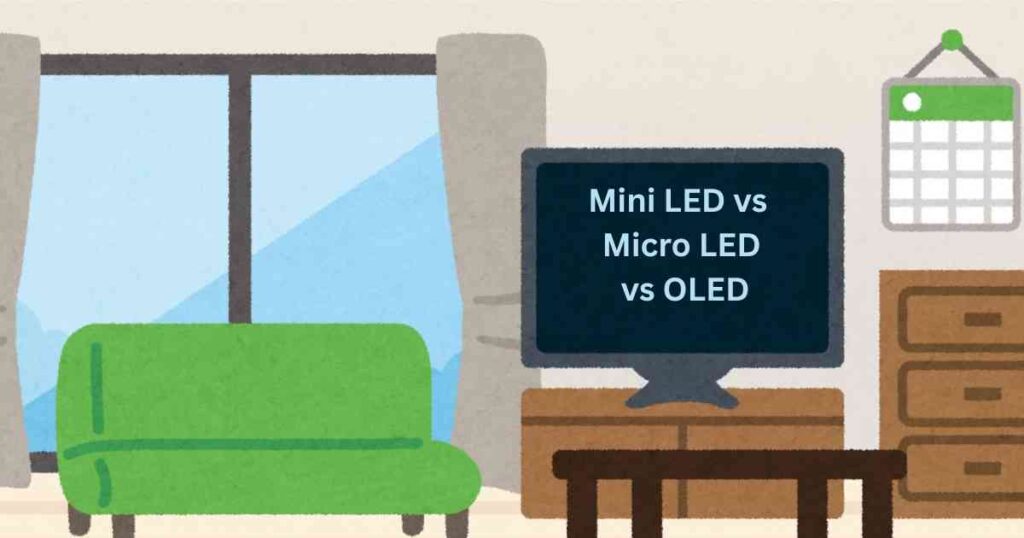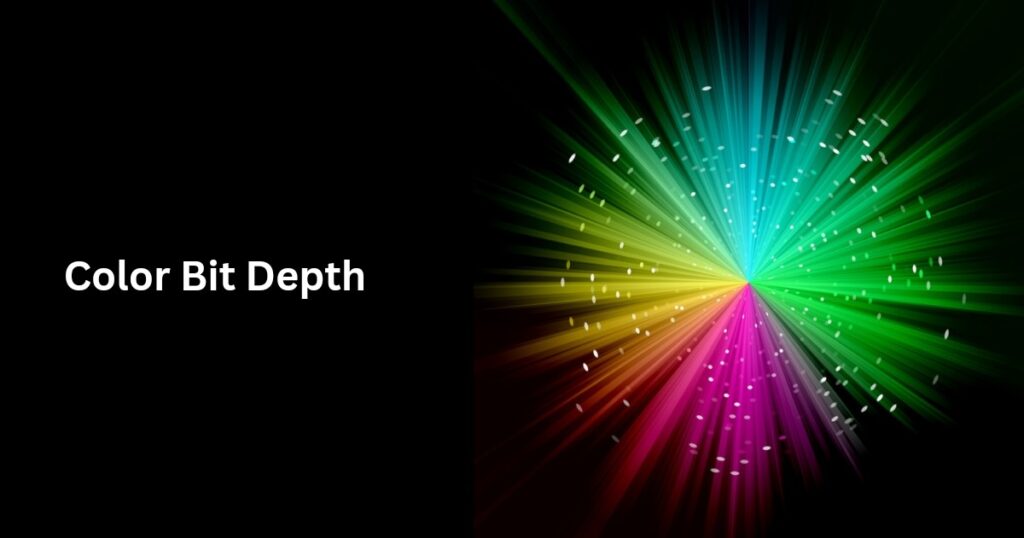Mini LED vs Micro LED vs OLED: Which is the best display technology?

The word LED is common to all three names mentioned above.
When you hear “LED,” you might instantly think of the lighting decorations used during family functions, birthday parties, or the lights in your room.
The LEDs about which we’re going to discuss here aren’t very different, except for one key detail: they are incredibly small. And it’s in this minuscule size that the real magic happens.
Before we explore the key differences between Mini LED vs Micro LED vs OLED, let’s first know the basic definition of each of them.
What is Mini LED?
A Mini LED TV is a type of LCD TV that uses much smaller LEDs, about one-fifth the size of regular LEDs in its backlight.
Thousands of these tiny LEDs are packed closely together in the backlight of a mini LED TV.
These LEDs emit white light, which then passes through RGB color filters to produce a wide range of colors on the screen.
What is Micro LED?
A Micro LED is roughly one hundredth the size of a regular LED.
Millions of these micrometer-sized LEDs are embedded directly behind the display panel of a Micro LED TV.
These LEDs are so tiny that they closely match the size of individual pixels.
Each pixel is made up of a combination of red, green, and blue Micro LEDs.
Thus, a Micro LED TV achieves very precise control over every single pixel on the screen.
What is OLED?
OLED stands for Organic Light-Emitting Diode, or simply Organic LED.
Unlike the miniature-sized inorganic LEDs used in Mini LED and Micro LED TVs, OLEDs are made from organic semiconductor compounds.
These organic LEDs are also small enough to match the size of individual pixels, allowing them to control each pixel independently.
To reproduce images, OLED displays use either color filters (WOLEDs) or a quantum dot layer (QD OLEDs) in front of the self-emissive organic LEDs.
Now that we’ve covered the basics, let’s dive into how each of these display technologies actually works and what kind of picture quality they deliver.
Let’s go.
Mini LED vs Micro LED vs OLED: What’s the difference?
The key difference between these three display technologies, Mini LED, Micro LED, and OLED lies in the size and type of LEDs they use.
This fundamental distinction significantly affects how each display performs.
Let’s explore how the nature of these tiny LEDs influences the overall display characteristics and consequently, the picture quality.
Mini LED
Compared to regular LED LCD TVs that use standard-sized LEDs in their backlight, Mini LED TVs incorporate thousands of much smaller LEDs.
These tiny LEDs are grouped into hundreds or even thousands of dimming zones.
This is a significant jump from few dozen dimming zones found in standard LED TVs.
This large increase in the number of dimming zones allows for far more precise local dimming, enabling the Mini LED TVs to dim specific areas of the screen more accurately.
As a result, they offer much better contrast than traditional LED TVs.
Due to precise control over the dimming zones, a common issue of blooming or light bleeding from the bright objects in dark areas which is generally faced in LED TVs, is very very less in a mini LED TV.
The Mini LEDs being inorganic in nature, are capable of achieving high brightness levels.
When paired with quantum dot technology, a Mini LED TV can achieve a wide color gamut and combined with its high peak brightness, it delivers a high color volume on the screen.
This results in a very impressive HDR performance with vivid colors and deep contrast.
But still, Mini LED TVs can’t achieve the same level of contrast as OLEDs.
Let’s see why.
OLED
OLED TVs feature self-emissive pixels, which means each individual pixel emits its own light and can be controlled independently.

Imagine having millions of dimming zones, one for every pixel.
An OLED can completely turn off any pixel when light isn’t needed, producing pure blacks and infinite contrast ratio.
On the other hand, Mini LED TVs, though equipped with hundreds or thousands of dimming zones, still rely on a backlight.
This backlight always shines through RGB color filters, even in areas where no light is required.
So while Mini LED TVs can dim those areas with great precision, they can’t turn individual pixels off completely.
As a result, they can’t achieve perfect black levels like OLEDs.
Having per-pixel control, OLED TVs offer exceptional color accuracy and a wide color gamut along with true blacks, thus delivering a superb HDR performance.
But one problem with OLED TVs is that their organic pixels have a limited lifespan.
These pixels are prone to degradation, especially when operated at high brightness levels for extended periods.
Because of this, many OLED TVs cannot reach the same brightness levels as average LED or Mini LED TV, as driving the organic pixels too hard increases the risk of pixel wear and consequently, reduced panel longevity.
Another concern associated with them is burn-in, which can happen when the same static content such as a channel logo, news ticker, or scoreboard is displayed continuously for long durations.
In such cases, the pixels in those areas can wear out unevenly, leading to permanent image retention.
This appears as a faint shadow or “ghost” image on the screen, even after you change the content.
Overcoming all these limitations, Micro LED TVs have emerged as the next-generation display technology.
Micro LED
These TVs use millions of inorganic micrometer-sized LEDs controlling each pixel individually.
Micro LED TVs use pure inorganic RGB light emitters behind every pixel to form the image, thus eliminating the need for color filters or any backlight.
Unlike OLEDs, Micro LED pixels are inorganic, which means they are not prone to degradation or burn-in.
This makes them far more durable and reliable over long-term use.
Moreover, Micro LEDs can be driven to extremely high brightness levels, reaching 10,000 nits and beyond, without compromising lifespan.
As each pixel in a Micro LED TV can turn off completely when not in use, they deliver true blacks.
The combination of exceptionally high peak brightness and perfect blacks results in infinite contrast ratio.
This makes the Micro LED TVs capable of delivering perhaps the best picture quality seen to date.
Since Micro LED TVs don’t rely on color filters or a quantum dot layer, there’s no barrier between the light source and the display.
This direct emission of light enables ultrafast response time within nanoseconds, far surpassing other display technologies.
Whether it’s bright room viewing, dark room movie watching, high-impact HDR performance, or fast-paced gaming, Micro LEDs excel in every scenario.
Mini LED vs Micro LED vs OLED: The Summary
OLED and Micro LED TVs offer the best possible contrast ratio, thanks to their self-emissive pixels that can turn off completely to produce true blacks.
A Mini LED TV, though having much improved contrast than traditional LED TVs, still relies on a backlight and come somewhere between LED and OLED in terms of contrast ratio.
When it comes to response time, Micro LED TVs are the leaders with ultrafast speeds in the nanosecond range.
OLEDs also perform very well, offering response times around 0.1 ms or even faster.
In comparison, Mini LED TVs may have response times above 1 ms, which, while sufficient for most content, does not match the fluidity of OLED or Micro LED in high-speed gaming.
Brightness, once a limitation for OLEDs, has been significantly improved with modern advancements.
Technologies like the use of Quantum Dots in Samsung’s QD-OLEDs and the Micro Lens Array (MLA) in LG’s latest OLEDs have boosted brightness levels significantly, making OLEDs more competitive with Mini LED displays in bright environments too.
Micro LED TVs achieve the best color gamut, color volume, brightness, and contrast, thus delivering the best overall HDR performance among all current display technologies.
They are followed by MLA-based OLEDs, QD-OLEDs and Mini LED TVs with advanced local dimming.
Burn-in can be a potential issue with OLED and QD-OLED TVs, as they use organic self-emissive pixels that may degrade over time, especially with prolonged display of static content.
However, manufacturers have implemented several built-in mitigation techniques such as pixel refresh, pixel shifting, and logo dimming to significantly reduce the risk of burn-in and extend panel lifespan.
On the other hand, Mini LED and Micro LED TVs use inorganic LEDs, which are not susceptible to burn-in or pixel degradation.
As a result, they offer greater long-term durability for users who frequently watch static content like news channels, sports, or use their TVs as monitors.
Mini LED vs Micro LED vs OLED: Which TV to buy?
It’s undeniable that Micro LED TVs offer the best display performance currently available, with unmatched brightness, color accuracy, contrast, and durability.
However, the biggest drawback is their extremely high price.
For example, the price of Samsung’s 146-inch ‘The Wall’ Micro LED TV is extremely high, putting it far out of reach for most consumers.
These TVs are more suited for luxury setups or commercial use than everyday home entertainment.
On the other hand, Mini LED TVs with advanced local dimming and quantum dot technology offer deep blacks, excellent HDR performance, and can become highly bright to fight all the glare in a bright room.
And the good news is that, they come at a fraction of the cost of Micro LED TVs, making them a much more practical choice.
Similarly, OLED TVs provide infinite contrast and pure blacks, thanks to their self-emissive pixels.
The QD-OLEDs and MLA-based OLEDs have significantly improved brightness, and with great reflection handling property, they have become well-suited for both dark and bright viewing environments.
They deliver deep blacks, large color volume and thus, outstanding HDR performance.
Therefore, investing in a high-quality Mini LED or OLED TV is a smart choice for now.
As for Micro LED TVs, they remain the ultimate display technology, but still would be a better choice for the future when they become much more affordable.


